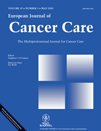Gemcitabine induced digital ischaemia and necrosis
Abstract
HOLSTEIN A., BÄTGE R. & EGBERTS E.-H. (2010) European Journal of Cancer Care19, 408–409Gemcitabine induced digital ischaemia and necrosis
A 70-year-old woman presented with a 7-day history of severe pain, paresthesia, oedema, acrocyanosis and punctate haemorrhagic lesions on her fingertips. The complaints began 2 days after the second cycle of a first-line chemotherapy consisting of cisplatin or carboplatin, and gemcitabine due to advanced urothelial carcinoma. At the fingertips of both hands, haemorrhagic and partly ulcerative lesions were found; these were attributed to vascular toxicity of gemcitabine. Therapeutically sympathicolysis by bilateral blockade of the brachial plexus was performed, accompanied by intravenous administration of the prostacyclin analog iloprost, fractionated heparin subcutaneously and oral therapy with corticosteroids and aspirin. Digital amputation could be avoided. Acral ischemia is a rare but probably underreported adverse effect of gemcitabine therapy and a potential source of misdiagnosis.




